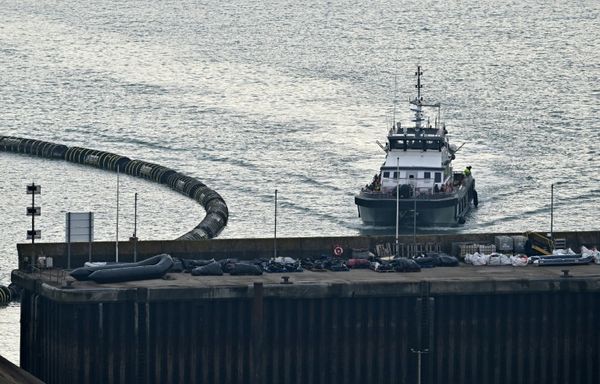
It was a darkly comic, made-for-media case: a Chinese hot air balloon flying about 20 kilometres over American soil, shot down by a US fighter jet over the weekend. It ignited a fairly confused diplomatic crisis, with China now saying it reserves the right to a response, and has laid bare the fragile state of relations between the world’s two most powerful nations.
The mere existence of the balloon — China claims it was a civilian weather-monitoring device, but the US is convinced it was spying, possibly on nuclear facilities — saw US Secretary of State Antony Blinken cancel his planned visit to meet his Chinese counterpart, Wang Yi.
It’s a worrying setback in efforts by the US and China to steady a relationship tattered by Chinese adventurism — of which the balloon is yet another example — and US determination to contain China’s rise, particularly regarding the technology underpinning its economic and military might.
In a reminder that there is nothing new under the sun, the incident echoes a 1960 incident in which a US U-2 spy plane was shot down over the USSR and its pilot, Francis Gary Powers, captured. This week’s jumpy, trigger-happy reaction by the US — destroying the balloon with a heat-seeking missile — and Blinken’s cancelled visit confirms that the two nations are in an effective Cold War, now with its own echoes of Dr Strangelove.
A threat or overreaction?
What’s curious about the furore over the shot-down balloon is that China appears to have been regularly deploying such balloons in recent years — there’s at least one aloft over South America. Indeed the US Defense Department admitted three such balloons were tracked during the Trump administration, making something of a mockery of claims by Republicans last week that President Joe Biden was being weak on China by not shooting it down (he was waiting until it was over clear water to avoid any injury or property damage).
The Pentagon also admitted it had been tracking the balloon for several days before its existence became public, and said it could not gather any more information than satellites could.
So there are more questions than answers. Why has such a fuss been made over one balloon? There are hundreds of spy satellites high enough to be beyond sovereign airspace that constantly look down on every square inch of the US, China, Russia and countless other countries.
The US has well over 100, Russia about 74 and China 68. A handful of countries have seven military satellites, including India, the UK and Germany. France and Israel each have a military satellite. Perhaps the accepted norm is that these satellites are so high their presence doesn’t count as an intrusion into airspace?
Spies will spy and this goes for myriad countries — including Australia — which are happy to spy whenever they can get away with it. And sometimes not. Close to home, we have the 2004 spying on the Timor-Leste cabinet and subsequent spying on the wife of then president of Indonesia, Susilo Bambang Yudhoyono, a moment at least as clumsy as the Chinese balloon.
Beyond balloons
In this new Cold War situation of rising international tensions, as well as Russia’s invasion of Ukraine, military assets and activities are being ramped up — and spying is part and parcel.
“Over the last decade, China has ramped up its space program, at least in part to allow the nation to use satellites for military purposes,” said Travis Langster, US Department of Defence principal director of space and missile defence policy, in a recent interview.
In that time, China has doubled its annual launches and its satellites in orbit, “launching over 150 satellites in 2022 alone, bringing China’s total to over 650. Among these many satellites are advanced communications systems able to transmit large amounts of data; improved positioning, navigation and timing capabilities; and increasingly sophisticated intelligence, surveillance and reconnaissance [ISR] technologies; and techniques improving what China can collect from space,” he said.
Security experts are also concerned that Chinese-owned companies have their gear embedded in devices and systems in the US and the West. Australia, the US and the UK have banned telecom networks and devices groups Huawei Technologies and ZTE.
There is also widespread use of Lenovo computers (formerly IBM), Motorola phones and Hikvision surveillance cameras, which are still used by the Australian government. On a broad consumer level, countless millions of people use the TikTok social media platform. All these companies are subject to the demands of China’s ruling Communist Party.
In October 2022, the US Federal Communications Commission confirmed the ban on Huawei and ZTE and indicated it would like to ban TikTok.
China’s response
China initially apologised (for getting caught) due to the balloon drifting low in American airspace, “regretting” that it had strayed off course — but its bristling reaction to it being shot down is nothing but posturing.
“China will resolutely uphold the relevant company’s legitimate rights and interests, and at the same time reserves the right to take further actions in response,” China’s ministry of foreign affairs said.
China’s reaction is hypocritical when we recall its response in 2001 to the EP-3 case, which involved a US spy plane nearing Chinese airspace — not actually intruding — but being shot down regardless. Unlike the balloon, there were people in that one.
The Chinese Communist Party’s propaganda department just couldn’t help itself, in the process inadvertently giving fresh fodder for China hawks, led by the Murdoch media, to urge more “tough on China” measures. Fox News in the US called it a “Sputnik moment” and “a Biden policy blunder”.
“Joe Biden must now be tough on China in the lead-up to next year’s presidential election, lest he be accused of being soft,” fulminated The Australian’s Adam Creighton.
Still, the balloon and the reactions around it are a symbol of the growing tensions between China and the US. It came hot on the heels of the surprise announcement that the Philippines would give the US access to four more military bases, bringing the total to nine.
The increased access to more bases “will make our alliance stronger and more resilient, and will accelerate modernisation of our combined military capabilities”, the US Defense Department said. Strategically this gives the US closer options to Taiwan.
Moves like this should concern Australia far more. As tensions continue to rise across the region about China’s clear intention to become the dominant power in the Pacific, and with Australia firmly in the US camp, the chance of being drawn into any stoush over Taiwan continues to rise.
Impact on Australia
America shooting down the balloon underscores the difficult path ahead for Australia in resetting its relationship with China, most particularly in trade. The mooted virtual meeting this week between Trade Minister Don Farrell and his Chinese counterpart, Wang Wentao, went ahead yesterday, the first such meeting in three years. It’s a first step, and Farrell has been invited to Beijing.
For Australia, the word in diplomatic circles is that some movement on trade is expected next month — maybe barley, maybe wine — as China and its now bruised-by-COVID President Xi Jinping focuses on an economy smashed by the pandemic and draconian lockdowns.
In terms of the balloon, why its appearance was revealed when it was, leaving the US little choice but to take action — and thus setting back relations once more — is surely the story. It’s likely we may never know, but the important thing is for Washington and Beijing to redouble their efforts to calm things down and not give in to the hawks.
Is the kerfuffle over China’s balloon just a lot of hot air? Let us know by writing to letters@crikey.com.au. Please include your full name to be considered for publication. We reserve the right to edit for length and clarity.







